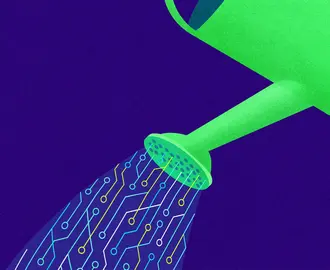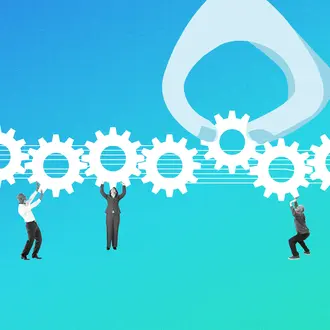Credit: Seita / Shutterstock
Manufacturers are counting on technologies and systems known collectively as Industry 4.0 to drive efficiencies and unleash new revenue streams in their sectors. Industry 4.0 leverages sensor technologies, advanced analytics, artificial intelligence, and machine learning capabilities to collect and analyze data.
Benefits include reducing production downtime, improving product quality, and enabling proactive maintenance.
But important factors, including legacy operations and failure to effectively engage frontline workers in operational redesign, often stand in the way of such large-scale transformation.
Momentum for Industry 4.0 is growing — one report by Statista projects the market will swell from $263 billion in 2021 to $1.1 trillion by 2028.
Interest is surging, in part, because sensor networks are the backbone for creating feedback loops to identify hidden factories, the poorly understood processes and workarounds that drive up production costs and slow systems down.
Spending on Industry 4.0 will swell from $263 billion in 2021 to $1.1 trillion by 2028.
Yet as organizations roll out Industry 4.0, they often end up collecting data at a much faster rate than it can be utilized, according to MIT Sloan senior lecturer
Carrier, who teaches the MIT executive education course “Implementing Industry 4.0: Leading Change in Manufacturing and Operations,” argues that the biggest impediments to Industry 4.0 transformation are operations practices and legacy mindsets that keep employees tethered to familiar work patterns, despite investment in new technologies and business process innovations.
Among the core challenges are:
Lack of standardization. There are too many variations in the old ways of working, which make it difficult to discover the business processes and workflows that will reduce business risk and improve productivity.
Ghosts of old technology. When new technologies and ways of working present a challenge, some employees will go back to what is familiar. Until employees develop confidence in the new technology, they will revert to the old system when put under pressure. Value is not realized until the old ways of working are phased out.
Insufficient preparation. Companies that invest in the latest sensors and advanced software often underestimate the level of workforce training required to use those tools to improve maintenance and diagnostics. Capital-intensive systems require more preparation — the level of preparation and training should be matched to the complexity of the machinery.
A blueprint for transformation
Based on experience with industrial clients, Carrier has formulated a blueprint to avoid the trap of purchasing technology that is underutilized or doesn't deliver the intended business outcomes. He advocates for a more measured transition process that draws on systems thinking and addressing cultural norms.
This will scope lofty Industry 4.0 visions into practical strategies and manageable next steps designed to improve internal processes. Key steps include:
Focusing on critical but manageable problems that will drive initial stages of transformation. Manufacturers often install networks comprised of hundreds of sensors and only then circle back to solve a specific problem. Technology does not make problems disappear. In fact, technology can exacerbate problems by creating data overload and eroding employees' trust in the new system.
“Wiring up and fixing five pieces of equipment instead of initially wiring up 500 can be advantageous,” Carrier said. “Otherwise, you risk spending 12 to 18 months on data warehousing, sensor calibration, and maintenance before realizing improvements in performance.”
Instead of launching a full-scale network with hundreds of sensors, Carrier recommends a moderated approach that pinpoints a specific problem and harnesses Industry 4.0 capabilities to solve it. Engaging employees to reveal critical stress points in their jobs and evaluating processes to identify opportunities for improvement and value creation is essential for broader transformation.
“The system is trying to tell you where it needs help,” Carrier said. “You have to learn to listen to the system to determine where sensors are needed. Use technology to help see what is missing and engage your operators in problem-solving.”
Start with “seeing” the missing feedback loops. Knowing where to establish a feedback loop is critical to Industry 4.0’s business value, but the question is where to start. The search for hidden factories can be fertile ground, as this exercise presents an opportunity to listen to the system and identify the largest gaps. It is also important to put processes in place that reduce the time from measurement to action. Collecting data that sits in a database or spreadsheet is insufficient to drive change.
For example, Heineken Mexico applied learning from this approach to solve a bottleneck at its production plant.
Sequence in technology adoption while removing unsustainable current systems. Deploying new technologies like sensors, cloud platforms, and advanced algorithms can empower workers with new insights. But as soon as they run into problems or encounter systems that are complex and unwieldy, they are going to revert to old systems and traditional ways of working.
By introducing tightly scoped and incremental Industry 4.0 initiatives, workers can more easily digest new systems and adjust to new work patterns. At the same time, it is important to remove old systems to eliminate fallback possibilities. Subtraction is harder than addition, and leaders must provide the space and time for their employees to incorporate the new technology and redesign their work.
Executive education Dec 12 – 14 2022: Implementing Industry 4.0



